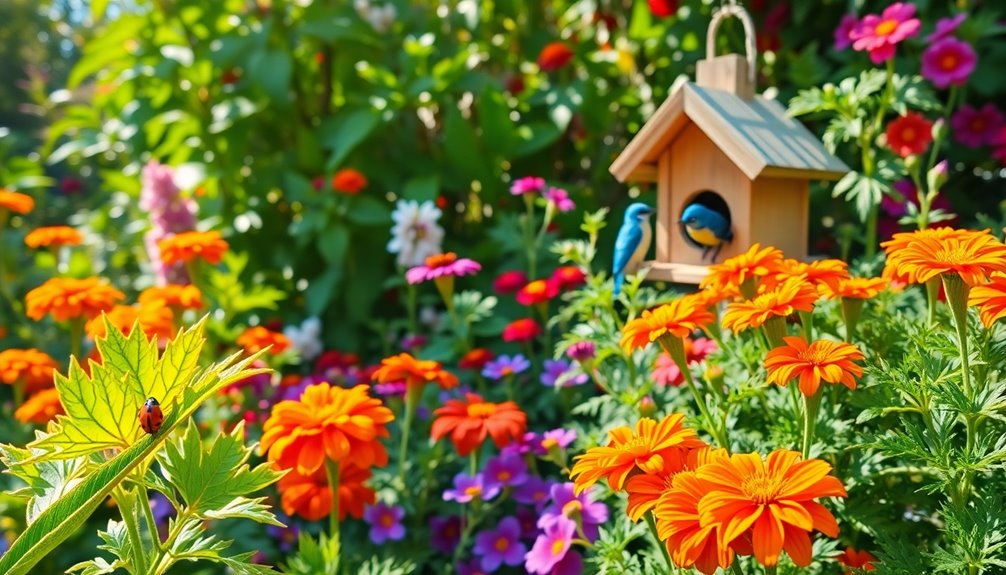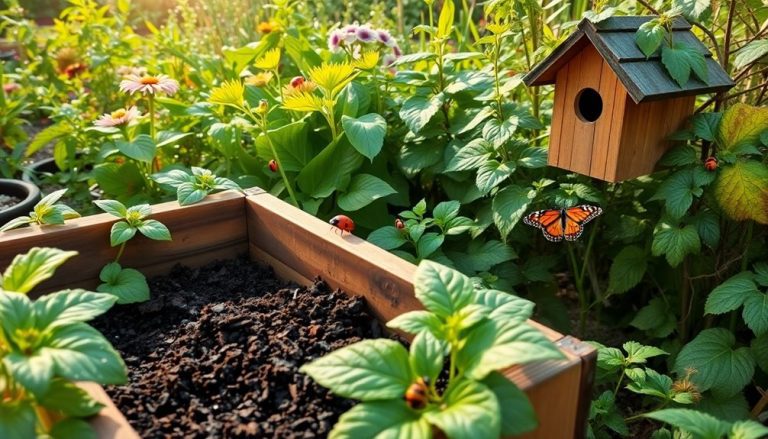Natural pest control techniques can help you maintain a healthy garden without harmful chemicals. Start by attracting beneficial insects like ladybugs and lacewings, which feast on common pests. You can also create homemade repellents using garlic, chili pepper, or neem oil. Consider companion planting; for example, marigolds repel nematodes while basil wards off aphids. Utilize natural traps and barriers like row covers and sticky traps to protect your plants. Finally, enhancing biodiversity by planting native species and adding birdhouses can further promote pest control. There's so much more to explore for a thriving garden ecosystem!
Key Takeaways
- Utilize beneficial insects like ladybugs and lacewings to naturally manage pest populations in your garden.
- Create homemade repellents using garlic, soap, or neem oil to deter pests without harmful chemicals.
- Implement companion planting by pairing specific plants to enhance growth and repel unwanted insects.
- Set up natural traps and barriers like row covers and sticky traps to protect crops from pest invasions.
- Promote biodiversity by planting native species and providing habitats for beneficial wildlife to enhance your garden's ecosystem.
Understanding Beneficial Insects
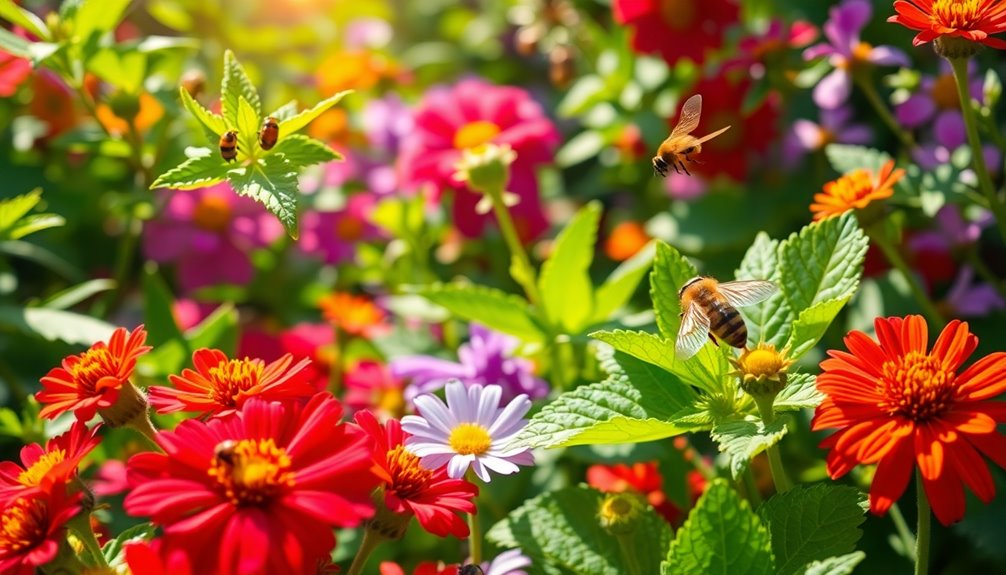
When you think about pest control, beneficial insects mightn't be the first thing that comes to mind, but they play a crucial role in maintaining a healthy garden ecosystem.
These tiny allies can help you manage pest populations naturally, reducing the need for chemical interventions. Ladybugs, for example, feast on aphids, while lacewings consume a variety of soft-bodied pests. Attracting these insects to your garden can significantly enhance your plant's health.
To encourage beneficial insects, you can create a welcoming environment. Plant a diverse range of flowers and herbs that provide nectar and pollen. Sunflowers, marigolds, and dill are excellent choices.
You might also consider leaving some areas of your garden undisturbed, allowing natural habitats for these helpful critters.
Avoid using broad-spectrum pesticides, as they can harm both pests and beneficial insects alike. Instead, observe your garden regularly to identify pest problems early and respond accordingly.
Homemade Pest Repellents
Looking to keep pests at bay without resorting to harsh chemicals? Homemade pest repellents can be your go-to solution. You can easily whip up effective mixtures using common household ingredients. Below is a handy table of some popular homemade repellents and their key ingredients:
| Repellent Type | Key Ingredients | Application Method |
|---|---|---|
| Garlic Spray | Garlic, water | Blend, strain, and spray |
| Soap Solution | Liquid soap, water | Mix and apply with a spray |
| Chili Pepper Spray | Chili powder, water | Steep, strain, and spray |
| Neem Oil Spray | Neem oil, water | Mix and apply to plants |
| Essential Oils | Peppermint, lavender, water | Dilute and spray on plants |
These simple recipes are not only eco-friendly but also effective against a variety of pests. Just mix your ingredients, apply them regularly, and watch as your garden thrives without unwanted visitors. Remember, consistency is key! Try these homemade solutions to create a healthier, pest-free environment for your plants.
Companion Planting Strategies
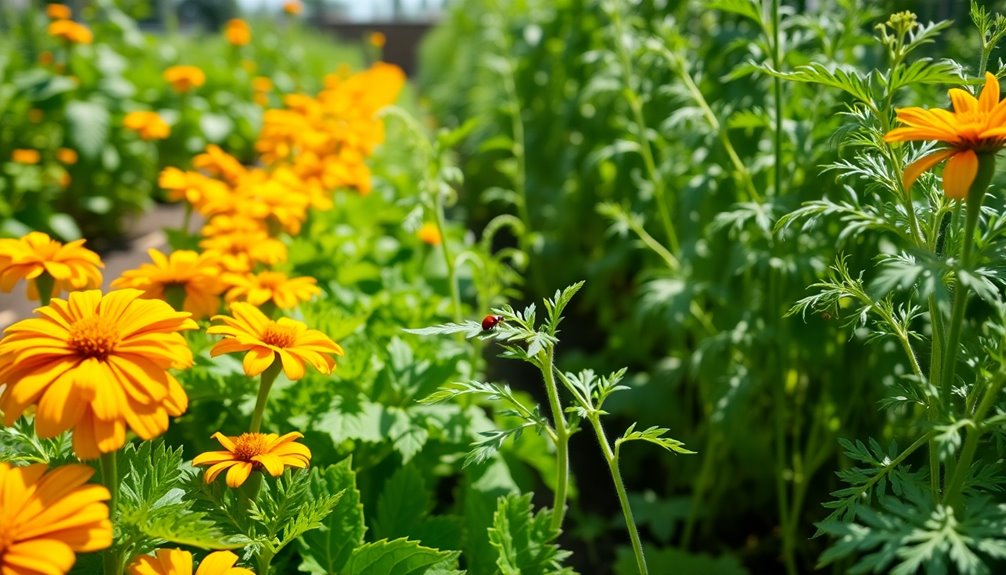
Homemade pest repellents are just one way to maintain a healthy garden.
Another effective strategy is companion planting, where you grow different plants close together to enhance growth and deter pests. This method can create a natural balance, allowing certain plants to protect others.
For instance, planting marigolds alongside your vegetables can repel nematodes and other harmful insects. Similarly, basil is a great companion for tomatoes, as it not only improves flavor but also wards off pests like aphids and whiteflies. You can also pair carrots with onions; the onion's strong scent can deter carrot flies.
To maximize the benefits of companion planting, research which plants work well together. Some combinations can attract beneficial insects, like ladybugs or pollinators, which further boosts your garden's health.
You'll want to keep in mind the growth habits and nutrient needs of each plant to avoid competition.
Implementing companion planting strategies will help you create a thriving ecosystem in your garden.
By carefully selecting your plant partners, you can enjoy a flourishing garden while minimizing pest problems naturally.
Give it a try, and you'll likely be amazed at the results!
Natural Traps and Barriers
Throughout the growing season, natural traps and barriers can effectively protect your garden from pests without the use of harmful chemicals. These methods not only keep pests at bay but also allow you to maintain a healthy ecosystem.
Here are some effective traps and barriers you can implement:
| Type | Description |
|---|---|
| Row Covers | Lightweight fabric that shields crops from insects while allowing sunlight and moisture in. |
| Sticky Traps | Yellow or blue cards coated with adhesive to catch flying pests like aphids and whiteflies. |
| Copper Barriers | Copper tape around pots or raised beds to deter slugs and snails due to a slight electric charge. |
| Diatomaceous Earth | A natural powder that dehydrates and kills soft-bodied insects when sprinkled around plants. |
| Companion Plants | Planting certain species together can create a natural barrier against pests, such as marigolds deterring nematodes. |
Promoting Biodiversity in Your Garden
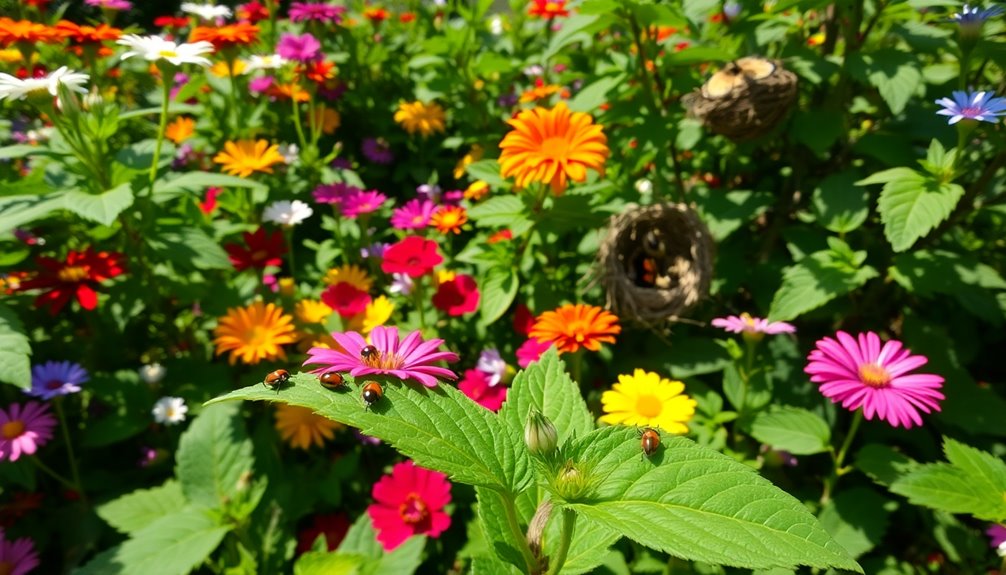
Promoting biodiversity in your garden is essential for creating a resilient ecosystem that naturally controls pests and diseases. By incorporating a variety of plants, insects, and wildlife, you'll encourage beneficial species that help maintain balance.
Start by selecting native plants, which are well-adapted to your local environment and support local pollinators like bees and butterflies.
Mixing different plant types—flowers, herbs, and vegetables—creates a diverse habitat that attracts a range of beneficial insects. Consider adding flowering plants that bloom at different times to provide food for pollinators throughout the growing season.
You should also provide shelter for wildlife. Adding birdhouses, insect hotels, or native shrubs can invite helpful creatures that prey on pests.
Avoid chemical pesticides that can harm these beneficial species. Instead, focus on maintaining healthy soil and water practices to support plant growth and resilience.
Lastly, practice companion planting by grouping plants that benefit each other, like tomatoes and basil. This method not only maximizes space but also fosters a thriving ecosystem that naturally keeps pests in check.
Frequently Asked Questions
What Are the Signs of Pest Infestation in My Garden?
You'll notice signs of pest infestation if you see discolored leaves, holes in plants, or sticky residue on surfaces. Keep an eye out for unusual insect activity and droppings, as these indicate potential trouble.
How Can I Attract More Beneficial Insects?
To invite beneficial insects into your space, plant diverse flowers and herbs. Think of your garden as a buffet; the more variety you offer, the more you'll attract those helpful allies ready to feast on pests.
Are Natural Pest Control Methods Safe for Pets?
Yes, natural pest control methods are generally safe for pets. You can use organic solutions that don't contain harmful chemicals. Always check product labels and ensure your pets aren't ingesting any treated plants or substances.
How Often Should I Apply Homemade Pest Repellents?
Think of your garden as a dance floor. You should apply homemade pest repellents every week or after rain, keeping the rhythm consistent. This way, you'll keep unwanted guests from interrupting your garden's joyous celebration.
Can I Use Natural Pest Control Indoors as Well?
Yes, you can use natural pest control indoors! It's effective and safer for your family. Try essential oils, vinegar, or diatomaceous earth, and always ensure proper ventilation to keep your living space comfortable and pest-free.
Conclusion
In your garden, every plant and insect plays a role in a delicate dance of life. By embracing natural pest control techniques, you're not just protecting your plants; you're nurturing a vibrant ecosystem. Think of your garden as a symphony, where each note contributes to a harmonious balance. As you implement these methods, you'll witness the beauty of nature unfolding—an enchanting reminder that, just like in life, the simplest solutions often hold the greatest power.

